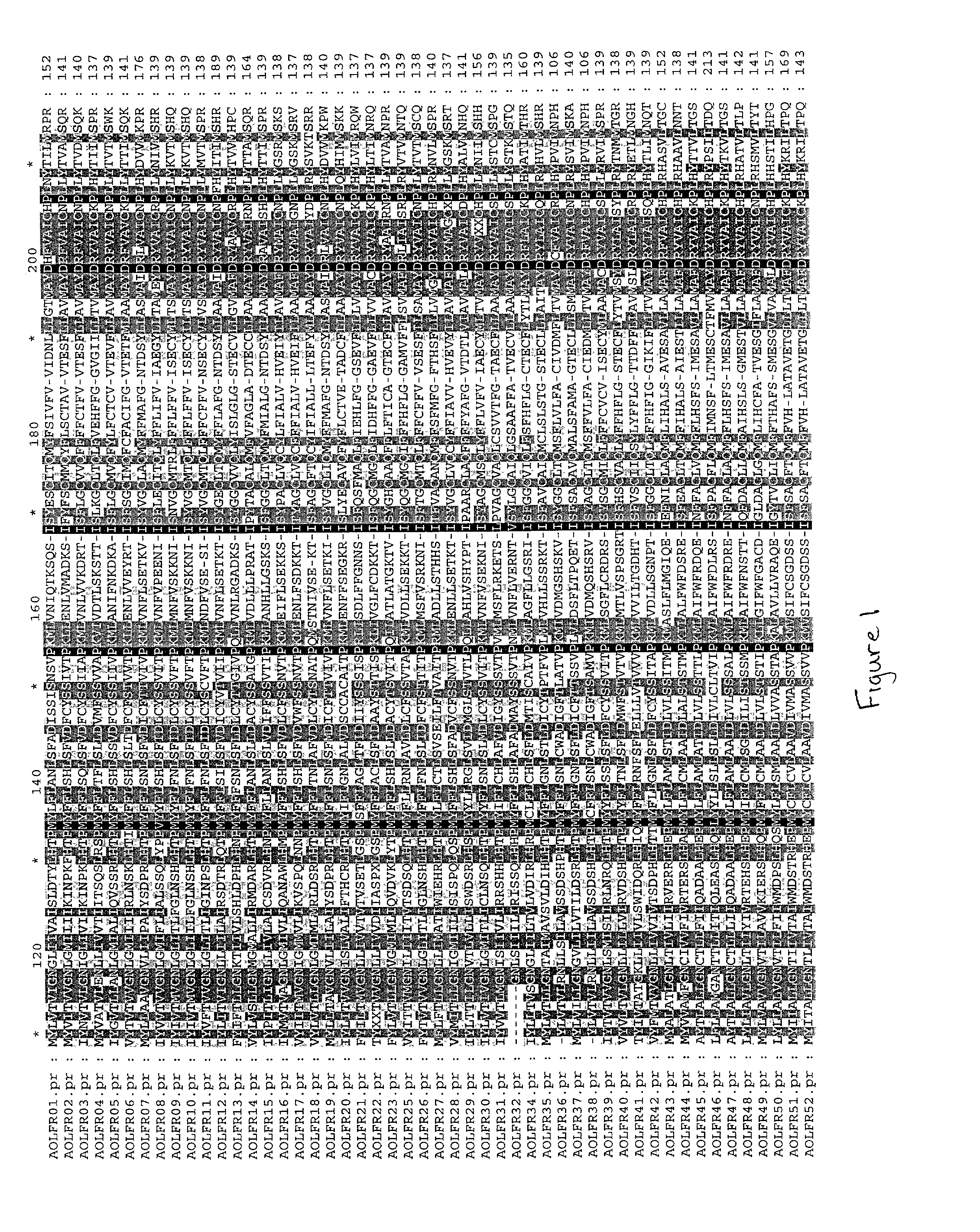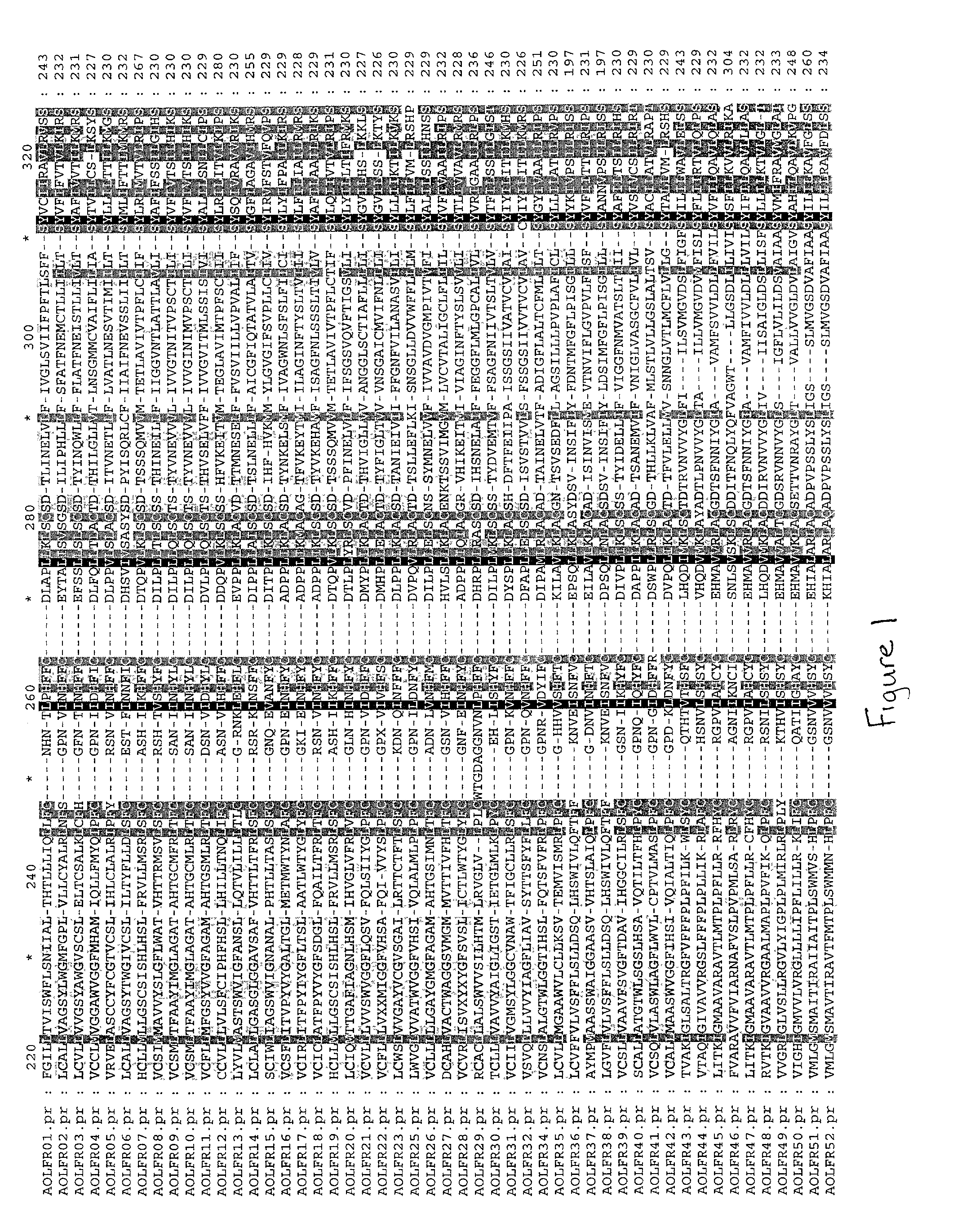Human olfactory receptors and genes encoding same
a technology applied in the field of human olfactory receptors and genes encoding same, can solve the problems of affecting the binding of g proteins, limiting the binding region of one potential ligand, and lacking information about ligand-receptor recognition,
- Summary
- Abstract
- Description
- Claims
- Application Information
AI Technical Summary
Problems solved by technology
Method used
Image
Examples
examples
[0252]
1 AOLFR1 sequences: MKTFSSFLQIGNMHQGNQTTITEFLLGFFKQDNLLFVL-FLGMYLVTVIGNGLIIVAISLD (SEQ ID NO:1) TYLHTPMYLFLANLSFADISSISNSVPKMLVNIQTKSQSISYESCITQMYFSIVFVVIDNLLLGTM AYDHFVAICHPLNYTILMRPRFGILLTVISWFLSNIIALTHTLLLIQLLFCNHNTLPHFFCDLA-PLL KLSCSDTLINELVLFIVGLSVIIFPFTLSSFFSYVCIIRAVLRVSSTQGKWKAF-STCGSHLTVVLLFY GTIVGVYFFPSSTHPEDTDKIGAVLFTVVTPMINPFIYSLRNK-DMKGALRKLNRKISSL ATGAAGACTTTTAGTTCCTTTCTTCAGATCGGCAGAAATAT-GCATCAAGGAAACCAAACCA (SEQ ID NO:2) AACTCACTGAATTCATTCTCCTG-GGATTTTTCAAGCAGGATGAGCATCAAAACCTCCTCTTT GTGCTTTTCTTGGGTATGTACCTGGTCACTGTGATTGGGAACGGGCTCATCATTGTGGCTA TCAGCTTGGATACGTACCTTCATACCCCCATGTATCTCTTCCTTGCCAATCTATCCTTTGCT GATATTTCCTCCATTTCCAACTCAGTCCCCAAAATGCTGGTGAATATTCAAACCAAGAGTC AATCCATCTCTTATGAGAGCTGCATCACACAGATGTACTTTTCTATTGTGTTTGTCGTCA-TT GACAATTTGCTCTTGGGGACCATGGCCTATGACGACTTTGTGGCGATCTGCCACC-CTCTGA ATTATACAATTCTCATGCGGCCCAGGTTCGGCATTTTGCTGACAGTCATCT-CATGGTTCCTC AGTAATATTATTGCTCTGACACACACCCTTCTGCTCATTCAATTGC-TCTTCTGTAACCACAA CACTCTGCCACACTTCTTCTGTGACTTGGCCCCTCTGCTCA-AAC...
PUM
| Property | Measurement | Unit |
|---|---|---|
| Tm | aaaaa | aaaaa |
| temperature | aaaaa | aaaaa |
| temperature | aaaaa | aaaaa |
Abstract
Description
Claims
Application Information
 Login to View More
Login to View More - R&D
- Intellectual Property
- Life Sciences
- Materials
- Tech Scout
- Unparalleled Data Quality
- Higher Quality Content
- 60% Fewer Hallucinations
Browse by: Latest US Patents, China's latest patents, Technical Efficacy Thesaurus, Application Domain, Technology Topic, Popular Technical Reports.
© 2025 PatSnap. All rights reserved.Legal|Privacy policy|Modern Slavery Act Transparency Statement|Sitemap|About US| Contact US: help@patsnap.com



